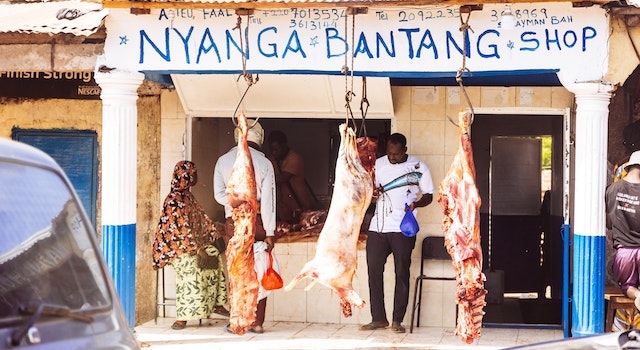Texas De Brazil Vs Fogo De Chao
Texas de Brazil is known for its variety of meats. This includes pork, lamb, and beef, as well as seafood, chicken, and lamb. They also provide many sides, including salads, vegetables, and desserts.
Fogo de Chao is known for its Gaucho-style food service, where servers will bring skewers full of meat for you to eat. They also provide a vast selection of different types of hearts and other unique dishes like feijoada (a stew made of black beans).
What Does Fogo De Chao Mean In Brazilian?
Fogo de Chao means “ground fire” and refers to the traditional Gaucho technique of cooking meats on an open flame.
Literal Meaning
In Portuguese, “Fogo de Chao” literally means “fire of the ground” or “ground fire.”
Cultural Significance
“Fogo de Chao” refers to the traditional gaucho technique of roasting meats in an open flame pit in the ground, a cooking style deeply rooted in the culture of food in southern Brazil, especially within the Rio Grande do Sul region. This is where Brazilian cowboys, also known as “gauchos,” would prepare large quantities of pork, beef, lamb, chicken, and others by skewering them before slow-cooking them in open fire pits.
Relation to Fogo de Chao Restaurant Chain
The term refers to an infamous Brazilian steakhouse chain called Fogo de Chao. It is famous for its “churrasco” style dining, an homage to the traditional method of cooking meats. The waiters are surrounded by large skewers made of various types of meat, cutting portions for guests at their tables in a manner called “rodizio.”
Is it true that Texas de Brazil has well-made meat?
Caipirinhas are also the national drink in Brazil. I could quickly eat a dozen tiny rounds of Brazilian cheese bread all by myself, I’m sure. But, as you’d guessed, there would be a challenge—I faced some issues also. Although I enjoyed many of the meat dishes served at the restaurant, some were not cooked well.
Rodizio Service
Texas de Brazil operates on the “rodizio” dining system, an approach to service found within Brazilian steakhouses. Gauchos (meat servers) serve the diners with skewers made of different kinds of meat, ranging from pork, beef, and chicken to lamb and Brazilian sausages, carved directly on guests’ plates.
Meat Doneness
As part of this kind of dining, Gauchos serve meat cooked to different degrees of quality. Suppose diners prefer their meat done and tender; they can ask the Gaucho. The skewered meat tends to be less fatty in the middle and more seasoned on the exterior, which is why the gauchos can accept a variety of tastes upon request.
Special Requests
Suppose the diner wants their meat cooked to perfection, and the gauchos have no heart that meets this criterion. In that case, most churrascaria eateries, including Texas de Brazil, are more than happy to prepare a cut of beef to the desired degree of doneness. They will then serve it to your table when it’s cooked.
What Is The Best Kind Of Brazilian Steak?
Picanha, Brazil’s preferred cut of beef, has been a popular choice in Brazil for many years as a tasty and affordable meat cut, especially when cooked using the traditional churrasco method. The amount could be more precise in the US without Brazil’s Brazilian Steakhouse.
Picanha
Picanha, also known as sirloin caps, rump caps, or rump covers, is the most sought-after piece of meat used in Brazilian steakhouse food. Picanha is renowned due to the layer of fat covering the cut’s side, which adds delicious flavor after cooking. The meat is usually wrapped in a C-shape, with the fat on the outside. While it cooks the fat layer, it bastes the heart, giving it an apricot flavor and moistening the meat.
Alcatraz
Alcatra is a term that means Top Sirloin; in English, it is another popular cut. It’s a massive cut of beef that provides an intense flavor. It is typically cooked using simple seasonings that allow the meat’s natural flavor to be evident.
Fraldinha
Fraldinha flank steak is delicious, with slightly tougher-cut meat. It has a deep, beefy taste that matches the churrasco grilling method. It is typically served thinly so that it is more tender.
Costela
Costela, also known as beef ribs, is another popular cut of meat in Brazilian food. Slowly cooked over an open flame, the ribs soften and are infused with a smokey taste.
Linguica
Although it’s not cut from steak, Linguica is an authentic Brazilian pork sausage that’s a sought-after element of a churrasco barbecue. With garlic and various spices, it’s an excellent accompaniment to cuts of beef.
Do You Consider It Polite To Leave A Tip In Brazil?
Brazilians are known for their friendly nature. However, tipping isn’t considered part of Brazilian tradition. But they tend to be direct and precise about the amount they need or don’t need. Restaurants are charged a 10 percent “service” charge, which is often added to the cost of the bill. While there’s no legal requirement to pay for it, it’s commonplace to pay for it.
Restaurants and Bars
In Brazil, there is a service fee of 10% that is usually added to the bill in bars and restaurants. The charge is typically listed on the invoice. Although it’s not a required charge, it is accepted and paid by most customers. If the service is incredibly excellent or there’s no charge, it is commonplace to leave a small tip.
Hotels
In the case of hotel services, like room maintenance and baggage handlers, a tip is appreciated but optional. The most common method is to leave a small amount of information daily for housekeeping and offer the bellhops a small amount of money in each package.
Taxis
Tipping taxi drivers is less prevalent in Brazil. However, rounding off the price and leaving an amount, particularly for friendly or exceptional service, is highly appreciated.
Salon Services
In salons, for services such as haircuts, massages, or other beauty treatments, a tip is appreciated too. A minimum of 10 percent of the amount is the norm.
FAQ’s
What is the difference between Texas de Brazil and Fogo de Chao?
Texas de Brazil and Fogo de Chao are both Brazilian churrascaria-style restaurants, but they have some differences in their offerings. Texas de Brazil offers a wider variety of meats, including lamb and pork, in addition to beef. Fogo de Chao, on the other hand, focuses primarily on beef cuts. Additionally, Texas de Brazil has a salad bar with a greater selection of side dishes and appetizers compared to Fogo de Chao.
How do the dining experiences at Texas de Brazil and Fogo de Chao differ?
The dining experiences at Texas de Brazil and Fogo de Chao are quite similar. Both restaurants follow the rodizio-style of service, where a continuous flow of skewered meats is brought to your table for you to choose from. At both establishments, you can enjoy an all-you-can-eat experience with various cuts of meat. The main difference lies in the specific types of meats offered and the overall ambiance and decor of each restaurant.
Which restaurant offers a better salad bar, Texas de Brazil or Fogo de Chao?
Texas de Brazil typically offers a more extensive salad bar compared to Fogo de Chao. Their salad bar includes a wide array of fresh vegetables, salads, cheeses, and other accompaniments. Fogo de Chao’s salad bar, while still quite good, may have a slightly smaller selection of items. However, it’s important to note that the main focus of both restaurants is the meat selection, and the salad bar is intended to complement the churrasco experience.
Do Texas de Brazil and Fogo de Chao have vegetarian or vegan options?
Both Texas de Brazil and Fogo de Chao offer vegetarian and vegan options, although the selection may vary. While the majority of their menu is centered around meat, they typically have a salad bar that includes vegetarian and vegan dishes, such as salads, grilled vegetables, and plant-based protein options. It’s recommended to check with the specific location or contact them in advance to inquire about their current vegetarian and vegan offerings.
How do the prices compare between Texas de Brazil and Fogo de Chao?
The prices at Texas de Brazil and Fogo de Chao can vary depending on the location and time of dining. Generally, both restaurants are considered upscale dining experiences and are priced accordingly. The cost of a meal at either restaurant is typically higher than a regular casual dining establishment. It’s advisable to check the respective websites or contact the specific locations for accurate and up-to-date pricing information.
Are reservations required at Texas de Brazil and Fogo de Chao?
While reservations are not always required, it is highly recommended to make a reservation, especially during peak dining hours or on weekends, as both Texas de Brazil and Fogo de Chao can be popular and busy. Making a reservation ensures that you have a table ready upon arrival and minimizes potential waiting times. Reservations can usually be made online or by calling the desired location directly.
Texas De Brazil Vs Fogo De Chao
Texas de Brazil is known for its variety of meats. This includes pork, lamb, and beef, as well as seafood, chicken, and lamb. They also provide many sides, including salads, vegetables, and desserts.
Fogo de Chao is known for its Gaucho-style food service, where servers will bring skewers full of meat for you to eat. They also provide a vast selection of different types of hearts and other unique dishes like feijoada (a stew made of black beans).
What Does Fogo De Chao Mean In Brazilian?
Fogo de Chao means “ground fire” and refers to the traditional Gaucho technique of cooking meats on an open flame.
Literal Meaning
In Portuguese, “Fogo de Chao” literally means “fire of the ground” or “ground fire.”
Cultural Significance
“Fogo de Chao” refers to the traditional gaucho technique of roasting meats in an open flame pit in the ground, a cooking style deeply rooted in the culture of food in southern Brazil, especially within the Rio Grande do Sul region. This is where Brazilian cowboys, also known as “gauchos,” would prepare large quantities of pork, beef, lamb, chicken, and others by skewering them before slow-cooking them in open fire pits.
Relation to Fogo de Chao Restaurant Chain
The term refers to an infamous Brazilian steakhouse chain called Fogo de Chao. It is famous for its “churrasco” style dining, an homage to the traditional method of cooking meats. The waiters are surrounded by large skewers made of various types of meat, cutting portions for guests at their tables in a manner called “rodizio.”
Is it true that Texas de Brazil has well-made meat?
Caipirinhas are also the national drink in Brazil. I could quickly eat a dozen tiny rounds of Brazilian cheese bread all by myself, I’m sure. But, as you’d guessed, there would be a challenge—I faced some issues also. Although I enjoyed many of the meat dishes served at the restaurant, some were not cooked well.
Rodizio Service
Texas de Brazil operates on the “rodizio” dining system, an approach to service found within Brazilian steakhouses. Gauchos (meat servers) serve the diners with skewers made of different kinds of meat, ranging from pork, beef, and chicken to lamb and Brazilian sausages, carved directly on guests’ plates.
Meat Doneness
As part of this kind of dining, Gauchos serve meat cooked to different degrees of quality. Suppose diners prefer their meat done and tender; they can ask the Gaucho. The skewered meat tends to be less fatty in the middle and more seasoned on the exterior, which is why the gauchos can accept a variety of tastes upon request.
Special Requests
Suppose the diner wants their meat cooked to perfection, and the gauchos have no heart that meets this criterion. In that case, most churrascaria eateries, including Texas de Brazil, are more than happy to prepare a cut of beef to the desired degree of doneness. They will then serve it to your table when it’s cooked.
What Is The Best Kind Of Brazilian Steak?
Picanha, Brazil’s preferred cut of beef, has been a popular choice in Brazil for many years as a tasty and affordable meat cut, especially when cooked using the traditional churrasco method. The amount could be more precise in the US without Brazil’s Brazilian Steakhouse.
Picanha
Picanha, also known as sirloin caps, rump caps, or rump covers, is the most sought-after piece of meat used in Brazilian steakhouse food. Picanha is renowned due to the layer of fat covering the cut’s side, which adds delicious flavor after cooking. The meat is usually wrapped in a C-shape, with the fat on the outside. While it cooks the fat layer, it bastes the heart, giving it an apricot flavor and moistening the meat.
Alcatraz
Alcatra is a term that means Top Sirloin; in English, it is another popular cut. It’s a massive cut of beef that provides an intense flavor. It is typically cooked using simple seasonings that allow the meat’s natural flavor to be evident.
Fraldinha
Fraldinha flank steak is delicious, with slightly tougher-cut meat. It has a deep, beefy taste that matches the churrasco grilling method. It is typically served thinly so that it is more tender.
Costela
Costela, also known as beef ribs, is another popular cut of meat in Brazilian food. Slowly cooked over an open flame, the ribs soften and are infused with a smokey taste.
Linguica
Although it’s not cut from steak, Linguica is an authentic Brazilian pork sausage that’s a sought-after element of a churrasco barbecue. With garlic and various spices, it’s an excellent accompaniment to cuts of beef.
Do You Consider It Polite To Leave A Tip In Brazil?
Brazilians are known for their friendly nature. However, tipping isn’t considered part of Brazilian tradition. But they tend to be direct and precise about the amount they need or don’t need. Restaurants are charged a 10 percent “service” charge, which is often added to the cost of the bill. While there’s no legal requirement to pay for it, it’s commonplace to pay for it.
Restaurants and Bars
In Brazil, there is a service fee of 10% that is usually added to the bill in bars and restaurants. The charge is typically listed on the invoice. Although it’s not a required charge, it is accepted and paid by most customers. If the service is incredibly excellent or there’s no charge, it is commonplace to leave a small tip.
Hotels
In the case of hotel services, like room maintenance and baggage handlers, a tip is appreciated but optional. The most common method is to leave a small amount of information daily for housekeeping and offer the bellhops a small amount of money in each package.
Taxis
Tipping taxi drivers is less prevalent in Brazil. However, rounding off the price and leaving an amount, particularly for friendly or exceptional service, is highly appreciated.
Salon Services
In salons, for services such as haircuts, massages, or other beauty treatments, a tip is appreciated too. A minimum of 10 percent of the amount is the norm.
FAQ’s
What is the difference between Texas de Brazil and Fogo de Chao?
Texas de Brazil and Fogo de Chao are both Brazilian churrascaria-style restaurants, but they have some differences in their offerings. Texas de Brazil offers a wider variety of meats, including lamb and pork, in addition to beef. Fogo de Chao, on the other hand, focuses primarily on beef cuts. Additionally, Texas de Brazil has a salad bar with a greater selection of side dishes and appetizers compared to Fogo de Chao.
How do the dining experiences at Texas de Brazil and Fogo de Chao differ?
The dining experiences at Texas de Brazil and Fogo de Chao are quite similar. Both restaurants follow the rodizio-style of service, where a continuous flow of skewered meats is brought to your table for you to choose from. At both establishments, you can enjoy an all-you-can-eat experience with various cuts of meat. The main difference lies in the specific types of meats offered and the overall ambiance and decor of each restaurant.
Which restaurant offers a better salad bar, Texas de Brazil or Fogo de Chao?
Texas de Brazil typically offers a more extensive salad bar compared to Fogo de Chao. Their salad bar includes a wide array of fresh vegetables, salads, cheeses, and other accompaniments. Fogo de Chao’s salad bar, while still quite good, may have a slightly smaller selection of items. However, it’s important to note that the main focus of both restaurants is the meat selection, and the salad bar is intended to complement the churrasco experience.
Do Texas de Brazil and Fogo de Chao have vegetarian or vegan options?
Both Texas de Brazil and Fogo de Chao offer vegetarian and vegan options, although the selection may vary. While the majority of their menu is centered around meat, they typically have a salad bar that includes vegetarian and vegan dishes, such as salads, grilled vegetables, and plant-based protein options. It’s recommended to check with the specific location or contact them in advance to inquire about their current vegetarian and vegan offerings.
How do the prices compare between Texas de Brazil and Fogo de Chao?
The prices at Texas de Brazil and Fogo de Chao can vary depending on the location and time of dining. Generally, both restaurants are considered upscale dining experiences and are priced accordingly. The cost of a meal at either restaurant is typically higher than a regular casual dining establishment. It’s advisable to check the respective websites or contact the specific locations for accurate and up-to-date pricing information.
Are reservations required at Texas de Brazil and Fogo de Chao?
While reservations are not always required, it is highly recommended to make a reservation, especially during peak dining hours or on weekends, as both Texas de Brazil and Fogo de Chao can be popular and busy. Making a reservation ensures that you have a table ready upon arrival and minimizes potential waiting times. Reservations can usually be made online or by calling the desired location directly.










